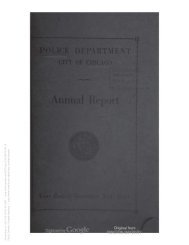Create successful ePaper yourself
Turn your PDF publications into a flip-book with our unique Google optimized e-Paper software.
EVERY DAY , hundreds of automobiles"die" in <strong>Chicago</strong>. No one knowsthe exact number. Many findtheir way to private auto graveyards.But an astonishing number are simplyleft to an inglorious death on city streets.The abandoned autos are not only aneyesore, but more important from thePolice Department's viewpoint, a traffichazard. One of the Department's mainresponsibilities is to keep traffic flowingsafely and efficiently. That's a bigenough job as it is. By the 1950s, itwas be<strong>com</strong>ing increasingly difficult byliterally thousands of abandoned carsclogging the public ways.LONG BEFORE ABANDONED autos becamea problem, the Illinois StateVehicle Law, passed in 1929, chargedthe "municipal officer" with this responsibility.By authority of the MunicipalCode of <strong>Chicago</strong>, the "municipalofficer" is the Police Department.Prior to September, 1960, the abandonedauto program was the responsibilityof the old Detective Bureau'sStolen Auto section. But this sectionhad more pressing responsibilites. Andas the number of cars sold throughoutthe country increased, so did the numberof abandoned autos. In 1959, the Departmenttowed only 1,706 abandonedcars from the streets. In some <strong>com</strong>munities,that might seem like a fa.ntasticnumber. In <strong>Chicago</strong>, it did noteven scratch the surface.In 1960, therefore, the AutomotivePounds section was created and giventhe responsibility for towing, custodyand disposal of all cars that came intopossession of the Police Department.Today, the section consists of 81 officers-thelieutenant in charge, 7 detectives,7 sergeants, 66 patrolmen, and 18civilians. It operates five Auto Pounds,with a total capacity of 5,595 cars. Italso has one auxiliary pound for usewhen the others are full.Along with the new section camesome revamping of cumbersome, outmodedprocedures.PERHAPS THE TWO KEY changes werein towing and disposal. Before April,1960, there were only two city-ownedtow trucks. Even when both were operating-whichwasn't often because offrequent breakdowns-they were totallyinadequate to do the job. The majorchange here was to switch to contractingwith private towing <strong>com</strong>panies.These <strong>com</strong>panies <strong>com</strong>pete on a bidbasis, with lowest bidders getting thecontract. At times, there are as manyas 36 trucks operating when demand ishigh. When demand is low, the numberis decreased. If the city were to ownthese trucks, many would be idle a goodportion of the year.Another major change was in themethod of disposal of the cars. By statelaw, the only way to dispose of the cars,other than return to owners, was bypublic auction. Thus, a virtual junkvalued at $5 had to be sold throughthe <strong>com</strong>plicated procedure of publicauction.The state law was amended in June,1961, to permit cars valued below $100to be sold by <strong>com</strong>petitive bids on a junkweight basis to licensed junk dealers.The change permitted a much faster,more efficient and cheaper. method ofdisposing of abandoned cars.BANDONED CARS are brought tD theA attention of the police throughtwo main sources: the beat officer andcitizens.Primary responsibility for keeping thestreets clear of abandoned autos lieswith the beat officer. If he sees a carin a <strong>com</strong>plete state of disrepair-missingengine, missing wheels, 1964 licenseplates-he writes up a Tow Case reportright there. The car can be towed almostimmediately.However, if the car appears to bedriveable, although in a state of deterioration,the officer writes a Tow Casereport but puts a sticker on the windshield,warning the owner that he mustmove the car within seven days or it willbe towed. He checks it seven days later,and if the car is still there, it is reasonableto believe the car is abandoned.When citizens call or write to the Departmentabout an abandoned car, a<strong>com</strong>munication form is sent to thewatch <strong>com</strong>mander in that district. Thena beat man checks the car, followingthe same procedures as above.When enough Tow Case reports ofabandoned autos <strong>com</strong>e in from a district,the cars in that district are towed.Normally, three districts are towed at atime by three units of trucks.The exception to this is what isknown as the "immediate" abandonedtow. These are abandoned cars the officerdetermines are a hazard-a traffic hazard,or perhaps a hazard to childrenwho find it a tempting "playground"6 <strong>CHI</strong>C<strong>AGO</strong> PO<strong>LICE</strong> STAR



